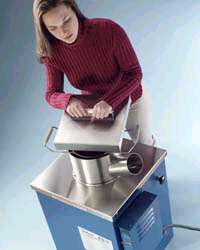
Cleaning of Extruder parts in plastics manufacture - The cleaning process itself is very simple, using the heat transferred from the fluidised bath to the tools to degrade the plastic residue. Objects to be cleaned, supported in a wire basket for ease of
Features
Cleaning of Extruder parts in plastics manufacture - The cleaning process itself is very simple, using the heat transferred from the fluidised bath to the tools to degrade the plastic residue. Objects to be cleaned, supported in a wire basket for ease of handling, are placed in the Fluidised bath, operating at a temperature between 450°C (842°F) and 550°C (1020°F) depending on the polymer, for approximately 20 to 30 minutes. Actual burn-off times and temperatures vary depending upon the weight, complexity and material composition of the item to be cleaned in addition to the quantity of residue to be removed. During the first two thirds of the total time the plastic is reduced to a tar mix state. In this phase all the initially combustible products of the plastic leave the fluidised bath as fumes, ducted away by means of appropriate fume extraction. In the last third of immersion time the tar mix state is reduced to carbon which either burns away or remains loosely bound to the tool. In the latter case it can be blown away or brushed off without causing damage, after the part is removed from the fluidised bath.
The clean item can then be put to one side, preferably on a steel plate, to cool before refitting on a machine or returned to the tool store. In some cases, particularly with dies from blow molding machines using PVC, a further operation of polishing with a soft cloth may be required. The aluminum oxide fluidizing medium is not degradable but will need to be replenished due to loss from spillage or entrainment in the exhaust. In the particular case of PVC, chlorinated hydrocarbons remain in the fluidised bath after burn-off and this dictates special maintenance procedures.
Heat Treatment and thermal analysis - The large working area allows metal tubing to be coiled up for use in change of state analysis of gases and liquids. Heat treatment and calibration of any device type that needs to be fully immersed into a dry heated environment. Using one of the optional baskets a large number of devices can be tested at one time. The excellent heat transfer of the aluminum oxide make Fluidised baths much more energy efficient than conventional ovens and far safer than salt baths.
IFB Series Industrial Fluidised Baths
The IFB Series Fluidised baths are controlled via a three term (PID) digital controller offering a resolution of 1 degree. Temperature feedback to the controller is from a type K' thermocouple. A solid state relay is used to pass power to the heaters during heat up and when maintaining the set temperature. Both units employ an independent over-temperature contactor to disable power to the heaters in the event of a controller or thermocouple failure. The main differences between the IFB51 and IFB52 are the total heater power and size of the working area, both of which are given below
Pricing on the Techne Calibration Baths may change without notice.
Please call for current Pricing. 618-465-7623
Please visit Industrial Process and Sensor for more info.